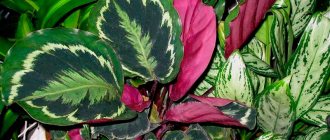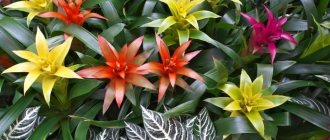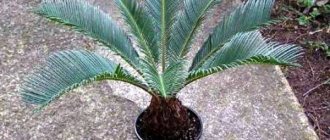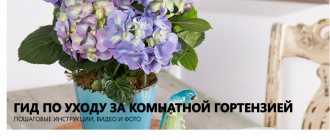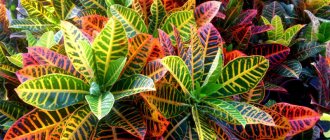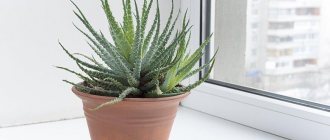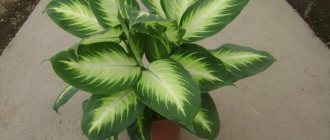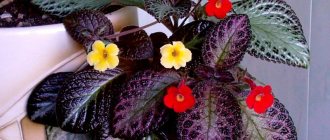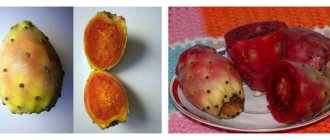Description
Tradescantia is a perennial vine and has about a hundred varieties.
The plant came to Europe thanks to the traveler John Tradescant, who was a gardener at the royal court of Great Britain. This unusual culture was named in his honor. As a rule, Tradescantia is grown as an indoor flower, but hybrids have been bred that take root well in open soil. The colorful shoots of bright green color add a special charm to the plant. They fall beautifully in a luxurious cascade from the flower pots. The leaf blades are smooth or grooved, their shape can be either lanceolate or oval. They grow on short petioles. Arc-shaped or parallel veins are clearly visible on the surface.
Varieties of the plant have a variety of leaf colors. There are specimens with both solid green leaves and variegated ones, decorated with stripes of various shades. Tradescantia flowers are small, with three delicate petals. Their colors can be different: white, pink, blue or purple. The flowers are collected in a few apical inflorescences located in the axils of the leaf blades.
At home, not all varieties are pleasing with flowering. Mostly hybrids and garden species bloom. Tradescantia well moisturizes the air around it, and also has the ability to neutralize pathogens near itself and dampen electromagnetic rays from electrical appliances.
Tradescantia - medicinal properties
Coleus is a beautiful and unpretentious plant.
The Tradescantia flower, which can be grown by amateur flower growers in our country, grows exclusively at home and is not just an apartment decoration, but a real treasure trove in the medicine cabinet, since in the Tradescantia flower the medicinal properties are manifested by various substances found in the flower , leaves, stems and roots. They have antimicrobial, wound-healing, anti-inflammatory effects and were discovered several centuries ago in the countries of Asia and America, where Tradescantia leaves were used to treat wounds, just as we use plantain.
In folk medicine, this plant is popular and takes its rightful place among other medicinal herbs. Tradescantia is used to treat severe infectious diseases such as tuberculosis.
Fresh wounds and scratches are treated with Tradescantia leaves as follows:
Ulcers with thrombophlebitis:
Furuncle. In the initial stage of boil development:
At the ripening stage or after opening:
For bruises, bruises, hematomas, apply fresh, uncrushed leaves to the affected area and secure with a bandage.
Flatulence due to colitis can be cured by regularly drinking an infusion of fresh Tradescantia leaves, a third of a glass, several times a day. Flatulence is a sign of intestinal dysbiosis, therefore, for the treatment to be effective, sweets should be limited in the diet.
The medicinal properties of the Tradescantia plant are also used for type 2 diabetes. Fresh shoots are brewed with boiling water, infused and the strained infusion is taken daily for two weeks.
When treating pulmonary tuberculosis, it is recommended as an additional remedy to prepare a mixture of shoots minced through a meat grinder. Dosage – a tablespoon three times a day before meals. The course of treatment is a month, after a week's break the course is repeated.
In addition to such serious diseases, Tradescantia is used for sore throat, runny nose, stomatitis, and calluses. To use plants for medicinal purposes, they should be planted in specially prepared soil and fertilizers should not be used.
We monitor copyright infringement in relation to our materials, therefore the use of materials is permitted only with the written consent of the site administration.
| | |
Guests
Home care for Tradescantia
Sundew - what kind of carnivorous plant is it?
Tradescantia is very easy to care for: it is not at all demanding in terms of maintenance conditions, it reproduces very easily, and thanks to its decorative foliage it continues to be popular among both experienced and novice gardeners.
Tradescantia has gnarled, succulent, bright green stems up to a meter long, succulent leaves and fibrous, tuberous roots. Tradescantia stems are very weak to climb, so they creep. But if tradescantia is hung, the waterfall of stems and leaves will become the center of attention for a long time.
- Tradescantia leaves grow from 5 to 15 cm in length. They are thin, like a blade, located alternately on the stems.
- Tradescantia leaves are flat or grooved, with parallel or arcuate veins.
- In most types of Tradescantia, the leaves at the base of the stem are slightly expanded and covered with small glandular hairs.
- Tradescantia leaves can be not only pure bright green.
- There are also many types of variegated Tradescantia with white, reddish or yellow stripes on the leaves.
Tradescantia flowers are boring and inconspicuous: they are very small and can be white, pink or purple. In garden species of Tradescantia, the flowers are most often bright blue, with three petals. They bloom early in the morning, while there is no bright sun, and close during the day. However, on cloudy days, Tradescantia flowers may remain open until the evening.
In our homes, the most commonly found plant is the white-flowered Tradescantia, which is popularly nicknamed “woman's gossip” for its irrepressible growth. Also in indoor conditions, Tradescantia riverine, Tradescantia crassia, and Tradescantia Blossfeld have proven themselves well.
Selecting a room
Tradescantia grows and develops very well in warm or slightly cool, but always bright rooms. With a lack of light, Tradescantia's stems begin to stretch out greatly, and the leaves on such stems are located very far from each other. Also, with a lack of light, Tradescantia leaves begin to lose color and become faded.
Tradescantia will feel great and look good in flower pots, baskets or pots hanging on the window. Then, even in winter you can observe its rapid, irrepressible growth.
Also, root rot can develop in a warm room if the substrate in the pot is too heavy, there is no drainage and there is overflow. In both the first and second cases, the plant will have to be urgently replanted. If the roots of Tradescantia are severely damaged, then the plant should be thrown out. Don't worry, take new cuttings from healthy shoots.
Soil selection
And before you plant these cuttings in a new pot, correct all your previous mistakes. You should not take soil for flowers from the garden. Although Tradescantia is undemanding to soil, it is still better to use ready-made flower substrate from the store.
You can make the substrate yourself by taking leaf humus, turf soil and sand in a ratio of 2:1:1:1, after freezing it or calcining it in the oven.
Watering
Tradescantia requires even watering; the soil in the pot should be slightly moist. If the room is cool in winter, watering is no more than 1-2 times a week; if the room has hot and dry air, there is a bright window, then watering is needed more often. Also, if the room is dry and hot, misting may be recommended to increase the humidity around the plant. If there is insufficient moisture, the tips of the leaves may dry out.
As I said earlier, Tradescantia is very easily propagated by cuttings cut from stems in coarse sand, water or plain soil; even root stimulants do not need to be used. To make the plant look lush in a pot or flowerpot, plant several cuttings of Tradescantia around the entire circumference of the container.
Tradescantia should be replanted as needed in the spring. No matter how well we care for Tradescantia, over time the plant’s stems become very elongated. Some gardeners constantly pinch the shoots so that the Tradescantia does not stretch too much and bushes better, others allow their Tradescantia to grow to its full height without pinching the shoots, and then take cuttings in the third year and replace the entire plant.
Flower transplant
In spring, the plant needs to be given attention, because it may lose its attractiveness and the color of the leaves will change. Replanting and pruning will help restore the flower so that it will once again please the eyes of the household.
How to care for Tradescantia after wintering:
- Trim off the tops of the stems. They can be placed in a glass of water and, after roots appear, planted in pots.
- Replant into a new pot, preparing fresh soil. For a young flower, the procedure is recommended to be carried out every spring. After reaching three years, repeat every 2-3 years.
Planting and replanting into new soil
When planting a plant, much attention is paid to the quality of the soil. You can prepare it yourself or buy it at a flower shop.
Soil and pot selection
The soil can be prepared as follows:
- deciduous soil - 2 parts;
- humus – 1 part;
- turf – 1 part;
- sand – ½ part.
Note! The soil should be light and fertile.
Be sure to pour drainage material at the bottom of the container to protect the flower from rotting of the root system. The pot should not be deep; the root system does not require much space. When transplanted, its diameter should exceed the previous one by a couple of centimeters.
Growing in open ground
Agave plant
In open ground, Tradescantia is kept as an annual plant or taken to a warm room for the winter. For planting, select a location protected from direct sunlight during the daytime, which will also be protected from strong gusts of wind. Planting is carried out in the second half of May - early June, when night frosts have subsided. A small plot of land is prepared for placement, which is carefully dug up and weeds are removed. After loosening, small planting holes are dug, at the bottom of which a small drainage layer in the form of coarse river sand or fine expanded clay can be placed. You can put a small amount of humus or well-rotted horse or cow manure on the drainage layer.
Too heavy, clayey soil is improved by adding organic matter and sand to improve drainage. The bushes are placed in planting holes at the same depth at which they were in the pots and sprinkled with earth in a circle. After planting, the substrate around the Tradescantia is compacted. Further care of the planted plants will consist of timely watering, fertilizing, loosening and weeding. The plants do not tolerate frost, so it is best to bring them indoors during the autumn months.
You may also be interested in:
- Date palm at home - care, how to grow from a seed, photo, fruiting when grown in a pot, replanting, why the plant turns yellow and dries, description - what the palm tree looks like, watering
- Alyssum - photo of a flower, planting and care in open ground, growing from seeds, keeping the plant in a pot - soil, fertilizer, lighting
- Hamedorea - photo of a palm tree, home care, replanting, reasons for leaves drying out, signs associated with indoor plants, reproduction, growing from seeds, diseases and pests, conditions of maintenance after purchase
- Violet - photo and description of varieties, care at home, flowering time, watering indoor violets, propagation, why plants do not bloom, how to replant a flower, diseases and pests
- Croton - photo, home care, flower propagation, plant types, signs, flowering time of codiaum, propagation by cuttings, pruning, why croton dries and leaves fall, replanting
Garden tradescantia - what kind of plant is it, how to plant it correctly
The plant in question is a bush flower. It usually reaches about half a meter in height. The plant received this romantic name thanks to the name of the biologist who first introduced European countries to this native of Virginia.
Externally, the bush looks very attractive. It has long, pointed green leaves with thin longitudinal grooves. And the flowers, of which there are quite a lot, have inflorescences consisting of three rounded petals. The shade of the petals varies from pink to purple. Tradescantia is notable for the fact that it blooms from May to September. Moreover, the blooming phase of one flower is short-lived, but due to the fact that there are many of them and they do not bloom at the same time, the bush looks presentable for such a long time.
Another advantage of garden tradescantia is that it is perennial. Over time, the bush grows, becoming more magnificent and richer.
- Most often, the plant is propagated by seeds. If you have collected them, do not delay sowing; freshly collected material germinates faster and better.
- Sowing can be done both in autumn and spring. But if you decide to plant seeds before the winter, then take care of insulating the plantings. First of all, select a suitable container - a wooden box is best suited for this purpose, in the bottom of which you need to drill several holes. After planting, cover the container or place it in a closed greenhouse so the plants can survive the winter cold.
- Garden Tradescantia does not like heavy soil. Therefore, the soil for planting it should be light and loose, as well as supplied with the necessary nutrients. If the soil in your region is poor, mix the soil with a complex fertilizer before planting.
- And don’t forget to thoroughly water the soil, and during growth, do not allow the earthen clod to dry out.
- The calculation of distances when planting is as follows - about one centimeter between seeds of one row, fifteen to twenty centimeters between rows.
How to properly care for garden Tradescantia
So, in order for the plant to please you with its appearance, follow a number of care requirements:
Watering.
Tradescantia is a moisture-loving lady, so it must be supplied with water regularly, especially in hot weather. During the cold season, watering volumes are proportionally reduced. At the same time, you should not water the flower too often, let this procedure be less frequent, but of better quality;
Feeding.
It is carried out during the most critical life periods of the bush. The first time the soil is enriched is at the planting stage, if the original soil is poor in nutrients. Next, fertilizing is added in the spring, during the period of active growth. When the buds begin to form, the fertilizer is applied again;
Loosening.
Garden Tradescantia loves loose soil and does not tolerate weeds nearby, so do not be lazy to remove them in a timely manner and loosen the soil around the base of the bush;
Insulation.
The flower needs to be prepared for wintering. To do this, as soon as it fades, you need to cut off the flower stems and then sprinkle the entire bush with peat. On top, gardeners form a “coat” of spruce paws. This insulation will be enough for a successful winter.
Even if care is correct and timely, the first flowers can be expected no earlier than the second year of the plant’s life.
There are three ways to propagate this flower:
- Using seeds.
- By cuttings.
To implement this option, you will need to cut one of the bush cuttings with leaves, and then place it in a container of water at room temperature. As soon as the roots appear, plant the young Tradescantia in a small box with nutritious soil and leave it in a warm room. When the plant grows and gets stronger, it can be planted in open ground.
- Dividing the bush.
The third option is considered the simplest. But when doing this, do not forget that the root system of Tradescantia is extensive, so when digging up a bush, take a good supply at a distance. It is best to propagate the plant in spring or autumn.
Pests. How to fight
Shchitovka
Brown spots on the leaves are scale insects. Usually located on the veins of leaves, along the stems. The bugs are practically motionless, hold tightly and are protected by a waxy shell so that even an insecticide may be useless. They suck the liquid from the leaves so that they turn yellow and fall off.
A folk remedy – soap solution or alcohol – will help fight this disease. You need to moisten the sponge with soapy water and completely cover the plant. Leave in this state for 4 hours, then rinse very thoroughly under running water. If necessary, repeat after a week.
“Bathing” in garlic tincture is also effective. To do this, the garlic pulp is passed through a garlic press, the resulting pulp is diluted with water and allowed to brew for a couple of days. Taking baths is exactly the same as taking a soap solution.
If the above folk advice does not help, then it is time for more effective chemicals. Effective drugs: karbofos, fufanon, actellik.
A visual representation of scale insects on leaves. This plant can still be saved; the leaf looks quite healthy. It is better to cut off a wilted leaf; even the death of insects will not return it to full existence.
Aphid
Withering young leaves and shoots indicate the presence of aphids. With this result, you should take a close look at your pet, and if you notice small, almost motionless, light green bugs, it means that you are looking at an aphid. The body size reaches 5 mm, it can be not only green, but also gray and even orange. It feeds on the juice of young buds and shoots, which is why it is concentrated in these places. The settlement of unexpected insects does not depend on insufficient supervision of your Tradescantia. Excessive and correct care at home does not protect it from aphids flying into the window, which are in a hurry to reproduce.
The folk method of fighting aphids involves treating the surface with dandelion. To do this, grind 30 g of roots and 40 g of leaves and add one liter of hot water. After infusion for two hours, wipe the Tradescantia every 10 days until it completely disappears.
If it’s not dandelion season, then, like scale insects, aphids die from a soap solution or liquid laundry detergent.
Fast-acting chemicals include karbofos and actellik.
Everything would be fine, but in addition to wilting, mucus appears on the leaves from the activity of aphids, which is immediately covered by a sooty fungus. A thin film of the fungus prevents the leaf from breathing, so it cannot be ignored. It can be easily removed with a soapy sponge in one go.
The photo shows a crowd of pests in an enlarged view. For us, these tiny creatures pose no danger, but look how detrimental they are to the plant on a large scale.
Pest Control
What to do if the stem is exposed? Don't worry - this is a natural process. As they grow older, the leaves fly off from below, but young and strong ones grow from above. Often, due to rapid growth, it is necessary to cut cuttings.
Tradescantia, which can be propagated using such cuttings, is first planted in one pot; during rooting, young shoots are planted in separate pots. Young seedlings quickly grow stronger, and with proper care they become graceful and lush.
In order to avoid virtually any problems, it is advisable to regularly inspect the leaves. Among the main guests it is necessary to note:
- Spider mites, which occur when the atmosphere in the room is excessively dry. You can find the insect in the internodes, where a web is formed. The leaves become limp and fly off over time. If you find a tick, you should treat the foliage and stems with soapy water, organizing an impromptu warm shower. If this does not help, then spray with a 0.15 percent Actellik composition (one or two milliliters per liter of plain water is enough).
- Scale insects usually dot the stem and leaves, sucking out the juice. The surface of the foliage becomes pale, then the foliage quickly dries out. Fighting scale insects is quite simple: as a rule, treating with a soap solution is enough.
With proper care and proper care, any house plant will look great
Do not forget to water it in a timely manner and surround it with your attention.
Rules for caring for Tradescantia at home
Tradescantia is a plant that does not require special attention.
Tradescantia is not a capricious plant and does not require much care. At home, it is often grown in flowerpots or in pots hung on a window or in another part of the room.
What kind of lighting is needed for a plant?
Tradescantias like to have light diffused, although they can withstand both bright sunlight and lack of light. It is best to place a pot with Tradescantia on the western or eastern side of the apartment; on the northern side it can also be comfortable; on the southern side additional shade may be required.
Plant species with variegated colors require more light. With a lack of light they turn pale and green. But too much sunlight can burn Tradescantia leaves too much, and they will burn out.
In summer, pots with Tradescantia can be moved to the balcony if it is protected from the wind and bright sunlight. It can also be planted in the ground at the dacha or in the garden.
Temperature conditions for indoor Tradescantia flowers
Tradescantia is an unpretentious plant; it is suitable for both average temperature conditions (20-24°C) and cool temperatures (7-13°C).
Watering the plant
In spring and summer, Tradescantia needs to be watered abundantly, and you also need to make sure that water does not accumulate in the pot. It is advisable to water a couple of days after the soil on top becomes dry. In winter, you need to ensure that the soil is moderately moist. Water two to three days after the soil dries out.
If Tradescantia is in cool conditions (10-15°C), it needs to be watered less often, after the soil has completely dried.
This plant can withstand long enough absence of watering, but this adversely affects it.
Air humidity
There are no special recommendations on air humidity for Tradescantia, but spraying in hot weather will only be beneficial
There are no special humidity requirements, but the plant likes to be sprinkled with water, especially in hot weather.
Fertilizer and feeding
In summer and spring, it is advisable to feed Tradescantia about twice a month; complex mineral and organic fertilizers are suitable. In autumn and winter, the plant does not need feeding. Species with variegated colors are not recommended to be fed with fertilizers of organic origin, because they may lose their original colors.
Transplanting and pruning Tradescantia
Tradescantia does not have to be replanted often, because This plant grows very quickly. But if such a need arises, then it is better to replant in the spring, combining it with pruning.
Types of propagation of indoor flower Tradescantia
Tradescantia propagates by seeds and cuttings
Tradescantia propagation occurs by planting seeds, cuttings or division.
It is better to propagate by seeds in spring. The seeds need to be sown in small greenhouses, where about 20°C will be constantly maintained. Greenhouses require constant ventilation and spraying. Flowers appear by the third year.
Propagation by cuttings can be carried out at any time. Young stems need to be cut into cuttings, about 15 cm each, and planted in pots of several pieces. In a couple of days the cuttings will take root.
Propagation by division is best done in the spring, when young stems begin to grow.
Diseases and pests of Tradescantia
The most common pests of Tradescantia are aphids, spider mites, and scale insects. They settle on both sides of the leaves, the leaves lose color and die. Aphids most often attack young stems and leaves.
Possible problems
- There are few leaves - there is not enough light, water and feeding.
- Leaves are the same color - there is not enough light.
- The leaves are limp, yellow, with spots - there is not enough water.
- The ends of the leaves are dry and brown – the air in the room is too dry.
After viewing the photos of Episcia, you will want to have this plant in your home.
Find out more about the birthplace of the cissus plant.
Useful properties of indoor Tradescantia
Tradescantia has long been known for its beneficial properties. Even Buddhist monks grew Tradescantia for medicinal purposes. Tradescantia leaves contributed to the rapid healing of wounds. In some countries, Tradescantia was taken orally, in Cuba it was used for disorders of the digestive system, in Jamaica for the treatment of tuberculosis, in Venezuela for the treatment of diabetes.
Currently, Tradescantia is used in medicine to treat boils, hematomas, purulent wounds, and periodontal disease. Watch the video about the medicinal properties of this plant, we wish you pleasant viewing.
Watering
Watering is carried out with water at room temperature (having medium hardness) and standing for 2-3 days.
On hot summer days, water should be abundant so that the soil in the pot does not dry out even from above. At the same time, make sure that the water in the pot does not stagnate.
In autumn, watering is gradually reduced and in winter watering is much less frequent than in summer. The regularity of winter watering depends on the room temperature.
It is necessary that the top layer of soil dries out by 1-2 cm, and only after that the plant needs to be watered. In the spring, from the beginning of May, watering the plants is gradually increased.
Types of Tradescantia
A small genus of perennial evergreen plants. Stems lodging, creeping. The leaves are green or purple, 10–15 cm long, on short petioles or sessile, arranged alternately. There are varieties with longitudinal pink stripes. The leaf blades have velvety pubescence. The flowers are pink, with 3 triangular petals, up to 2 cm in diameter.
3.2.Virginian Tradescantia - Tradescantia virginiana
One of the subspecies of Anderson's Tradescantia, it is a herbaceous perennial plant up to 90 cm high. The leaves are arched, linear, slightly bent along the central vein. Flowers with three petals, white, violet-blue, pink or purple, relatively large - up to 4 cm in diameter, with bright yellow stamens, collected in small inflorescences - umbrellas. The flowering period is long, occurring at the end of May - beginning of July. Flowering is abundant and attractive.
Herbaceous, evergreen, perennial, bushy plant. Zebrina variegata grows quickly, its stems can reach 180 cm in length. The leaves are sessile, oval or spear-shaped, 5 - 10 cm long, with sharp tips, very varied in color, but all have stripes. Young leaves and the undersides of adult leaves are purple. Pink, white or purple small flowers with 3 petals appear in spring and summer, but are not particularly valuable.
Reo is a monotypic genus consisting of only 1 species - an ornamental deciduous evergreen herbaceous plant. Long - up to 30 cm, sword-shaped, hard leaves of rheo are located on a strong, low trunk. The lower surface of the leaf blade is colored red or purple. The flowers are small, white, inconspicuous, axillary. Variegated varieties have longitudinal light stripes - white or pink.
3.5.White or white-flowered Tradescantia - Tradescantia albiflora
Plants that have probably gained the most popularity among Tradescantia at the present time. They are a very beautiful, often miniature species with bright striped, very light - almost white leaves and very delicate white flowers. Unfortunately, this plant requires a lot of sunlight; when grown in partial shade, the leaves may turn green.
3.6. Small-leaved or riverine Tradescantia - Tradescantia fluminensis
Perennial, evergreen, herbaceous plant with long, pendulous stems. It forms such a magnificent shape that when grown in hanging pots, it resembles a wig from a distance. The leaves are oval, fleshy, green, up to 5 cm long. The underside of the leaf blades is often painted in a contrasting purple hue. The flowers are tiny, three-petaled, white, and can appear at any time of the year. Indoor tradescantia rarely pamper gardeners with the appearance of buds.
Small-leaved Tradescantia is sometimes used as a dense ground cover.
Perennial, evergreen, herbaceous, “shaggy”, succulent plant with branched, rather thick, creeping shoots. The leaves of this variety are lanceolate or linear, glossy, fleshy, covered with delicate white fluff, and arranged alternately. The flowers are axillary, blue or purple, and are not of particular interest. Externally, the plant resembles the related Tradescantia. In some varieties, the underside of the leaf blade has a burgundy tint.
3.8. Tradescantia blossfeldiana
A very unpretentious, groundcover perennial plant with creeping, thick, abundantly branching stems and dark green, narrow leaves. The lower surface of the leaf blades has rich, attractive pubescence. At any time of year, the plant may produce pink, blue, purple or white flowers with three petals.
3.9.Lodges Tradescantia - Tradescantia loddgiesii
A bright decorative foliage plant with long leaves. The upper part of the leaf blade often has three-petal flowers, inconspicuous, small, white or pink.
A compact succulent plant with thick, relatively short, branching shoots, on which fleshy, boat-shaped leaves 2 - 3 cm long are very densely located. The color of the leaves varies from dark green to pinkish and burgundy. The flowers are small, unattractive, with 3 pink petals.
You might also be interested in:
Hibiscus
Coleus
Ficus
Chlorophytum
Description
This is a hanging crop that forms “waterfalls” of shoots of different colors depending on the type and variety. The length of the branches can reach 80 centimeters.
Some of its species are ground cover. In our middle zone it is used for landscaping the most diverse, most secluded corners of the winter garden and an ordinary apartment; it feels great in the shade and in the sun, in cold and heat.
Named after the father and son Tradescant, Englishmen, travelers and botanists, founders of one of the first botanical gardens (17th century, beginning) of London.
It is believed that Tradescantia weakens electromagnetic radiation from electrical appliances, increases the humidity of the room, and is a talisman for its owners. This is a filter plant that purifies the air from harmful fumes.
“Woman's gossip” is another name for Tradescantia, which was given to it for its long shoots intertwined with each other. But perhaps also for the fact that he protects his master from evil slander and gossip.
They are distinguished by a wide variety of leaf colors: green, purple, variegated, yellow, with various stripes. The shape of the leaflets is ovoid, lanceolate, ellipsoid.
Reproduction methods
These flowers can be propagated by seeds or vegetatively.
Tradescantia is grown from seeds only to select new plants with unusual shades of flowers or foliage. But this plant is propagated vegetatively in order to preserve the main characteristics of the variety. Usually those plants that have lived for two seasons are divided. Such plants have already grown several stems. The cuttings are cut so that each has 2–3 nodes with leaves. The cuttings are planted in boxes with coarse river sand at an acute angle to the soil, one node is buried in the sand, the foliage from which is cut off. Plants are watered constantly, but not abundantly. After 20–25 days, the cuttings form a root system. In this case, the plants can be transplanted to a permanent location.
There are about 10 varieties of garden Tradescantia. And all of them are in demand by flower growers and landscape designers not only in our country, but also in many European countries. This climbing plant is recognized by flower growers and is actively used in decorating plots, park areas and public gardens. The unpretentiousness of hybrid varieties and their long flowering are the main advantages of Tradescantia.
← Feeding roses: types of fertilizers, timing and application rules ← Oleander in the garden: how to grow a luxurious plant
Caring for Tradescantia at home
Requirements for the conditions of keeping Tradescantia vary depending on their natural habitat. Hairy plants with dense and thickened foliage are more hardy. They tolerate direct sunlight better and are less dependent on the frequency of watering.
Indoor tradescantia with smooth thin leaves love partial shade and grow best in moderately moist soil. At the same time, variegated varieties are more demanding on lighting. Under the bright sun they turn pale, and in the shade they risk losing their pattern and becoming completely green.
It is best to find a place for indoor Tradescantia, as in the photo, on an east or west window. On the south side the plant will need shading, but on the north there is danger:
- excessive stretching of shoots;
- reduction of leaves;
- lack of flowering;
- rapid loss of decorative effect.
Most species are heat-loving, but in the summer months it is useful to take Tradescantia out to the balcony, garden or loggia, having first protected the pot from the scorching sun and drafts.
Comfortable temperatures for Tradescantia range from 20 to 25 °C in summer, and a few degrees lower in winter. Although cool wintering is preferable, in many cases indoor Tradescantia grows well without seasonal changes in conditions. The air becomes critically cold for plants at a temperature of 10–12 °C.
Many Tradescantia, in addition to the indigenous inhabitants of semi-deserts, are excellent at keeping in moist soil and in the warm season require frequent and abundant watering, foliage irrigation and showering. The earthen ball should be evenly moist after watering. Since only the top layer usually dries out before the next procedure, indoor Tradescantias are watered at least every other day in the summer.
The culture is characterized by rapid growth, so caring for indoor Tradescantia at home must include fertilizing. They are carried out in the summer months and spring with an interval of 10–14 days. The plant is quite suitable for ready-made complex fertilizers for indoor crops, but for variegated forms you will have to take a special approach. Due to the abundance of organic matter, such indoor Tradescantia actively grows foliage, although it may lose the decorative variegated color of the greenery.
Features of care - lighting and temperature conditions
In home growing conditions, Tradescantia prefers bright, diffused light; it is better to limit the amount of direct sunlight, especially in summer, but variegated varieties are more light-loving.
A normal room temperature of 18 to 22˚C is quite acceptable. In the cold season, it is better to keep the plant away from radiators and ensure a minimum temperature, but not lower than 12˚C. It is worth saying that zebrina can tolerate even a short-term drop in temperature to 0˚C.
Tradescantia appearance
Tradescantia - Tradescantia is a perennial herbaceous indoor plant from the Commelinaceae family. It has long and rather fragile creeping or straight stems, densely covered with foliage. The leaves are elliptical, ovate, lanceolate, their shape, size and color depend on the plant variety. In most species, the leaves are small and smooth, sometimes pubescent.
Some Tradescantia leaves are solid green, others have striped leaves with white, cream, yellowish stripes, sometimes there are pink, red, lilac, and purple shades.
Small and not very bright white, lilac, pink, purple three-petal flowers are collected in apical inflorescences.
Tradescantia received its name from the gardener of the English King Charles I, John Tradescant the Elder, who was the first to describe this plant. In England, it began to be grown in the middle of the 17th century.
The plant received its Russian name – “woman’s gossip” – for its stems hanging down and clinging to each other.
Tradescantia is native to the tropics and subtropics of North and South America.
Today, more than fifty species of Tradescantia are known. Some of them are used in indoor floriculture. Tradescantias look beautiful in large containers, planted several at a time. Flowerpots with it can be placed not only on tables, stands, windows, but also on walls, in flower pots; Tradescantia looks very original as an hanging plant.
Main plant varieties
If we talk about what Tradescantia looks like, it is worth noting that the stems of the plant are quite long, hanging to the ground. The leaves are lanceolate and can also be elongated into an ellipse. The place of origin of Tradescantia is called the American continents, namely their tropical and temperate zones.
The number of species that make up the genus of this plant is quite large. In total, about thirty varieties of Tradescantia known today can be distinguished. Indoor plants include species such as:
- White-flowered (Tradescantia sitara tricolor, uridis);
- Blossfeld;
- Striped Tradescantia;
- Prirechnaya.
The white-flowered variety of the plant is of South American origin. The stems of the plant are long, spreading along the ground, the leaves are large, wide, elongated with pointed tips, smooth to the touch. The shade of the leaf blades is greenish, with whitish lines (the color depends on the plant variety). The flowers are snow-white, very small. Varieties of this species differ from each other mainly in the color of the stripes on the leaf blades and the shade of the foliage itself. For example, the Tricolor variety is characterized by pinkish-lilac or snow-white lines, the Aurea variety is characterized by green stripes on yellow leaf blades, etc.
Blossfeld's homeland is Argentina. The branches are creeping, raised, the leaf plates are elongated, elliptical in shape, pointed at the top; the leaves are covered with whitish fibers at the bottom. Their length is approximately 8 cm, their width reaches 3 cm. The leaf blades are green with a reddish tint on top and turning purple at the bottom. The flowers are small and pinkish. This species is considered the most common among summer residents and flower growers, and its main feature is the few yellow and green lines covering large leaves.
Striped Tradescantia is characterized by drooping or creeping smooth branches with a reddish tint. The leaf plates are elongated, egg-shaped, reach 8 cm in length and about 5 cm in width. The green leaf plates on the surface are covered with silver stripes on the outside and red on the inside. The flowers are small and purple in color.
The riverine variety of the plant also has a second name - “myrtle-leaved”. The homeland of this species is Brazil. The branches of Tradescantia are red, there are green specks that creep. The leaf plates are elongated, the surface is smooth to the touch. They stretch approximately 4 cm in length and 2.5 cm in width. The foliage is green on the outside and reddish on the inside.
Growing and caring for citrofortunella at home
The riverine species of the plant is famous for two varieties: Variegata, which is distinguished by a beige tint of stripes, and Quicksilver, which has white lines on the foliage.
Garden views
Despite the fact that this plant is grown primarily as a houseplant, there is a specially bred type of Tradescantia that can tolerate low temperatures. Anderson's Tradescantia is ideal for growing outdoors.
The varieties of this plant are bred from the Virginia variety, which is an ornamental perennial herbaceous plant growing in garden plots. Anderson's Tradescantia is great for both home breeding and outdoor gardening. This plant has one characteristic feature - the flower loves cloudy weather.
The shoots of this species are straight, branched, the leaves are narrow, elongated green and purple. The flowers are white, but can also be pink, purple or blue, and grow in inflorescences.
https://youtube.com/watch?v=9T3TpqlMHQc
How to prune and replant tradescantia
To prevent Tradescantia from becoming an elongated, bare plant, but to have a lush appearance, it must be regularly trimmed (pinched). In this case, it will actively grow in width and look like a dense bush.
Pinching of stems is carried out during the entire warm period of time. Cuttings are used for vegetative propagation of the crop. First, they are placed in water for rooting, then planted in pots of three to four pieces. The length of the seedlings should be more than 5 cm.
This plant cannot be replanted in soil oversaturated with organic matter. It will not bloom in such soil.
For home Tradescantia, a special substrate intended for indoor plants is well suited. An alternative could be a mixture of turf soil with peat and sand in equal parts.
Answers to readers' questions
What is the lifespan of a plant?
Tradescantia is not kept for more than 2-3 years. It loses its decorative appearance, many branches become bare, so a new plant is grown regularly at these intervals.
Is this flower poisonous?
Most types of Tradescantia are not poisonous. Many lovers of decorative fish place pots on stands above the aquarium so that the branches of Tradescantia descend into the water, and the fish happily pluck the leaves that are in the water.
Tradescantia pallidum contains a small amount of toxic substances. It may cause redness of the skin.
Why do the leaves turn yellow (dry)?
The main reason for this phenomenon is drying out of the soil, which Tradescantia cannot tolerate. Stagnation of water in the pot is also possible. In reo, this may be caused by watering with cold water.
How does the plant overwinter?
Tradescantia overwinters well under normal room conditions, but it must be kept away from heating devices and regular spraying must be continued, limiting watering, but not allowing the soil to dry out. If there is a glassed-in loggia suitable for wintering plants, then it is better to place the geranium there and spray it only once a week.
Diseases and pests
- Tradescantia leaves turn yellow if it lacks moisture.
- If the air humidity is too low, the tips of the leaves begin to dry out.
- Too long shoots and a small number of leaves indicate a lack of lighting.
- If the leaves turn black, it may be due to rot.
- In open ground, the plant may suffer from aphids and slugs.
- Before winter, the flower begins to lose its decorative appearance. Its shoots become long and its leaves dry out. To rejuvenate the flower, replant.
- Lack of flowering most often occurs due to excessive fertilization with organic fertilizers.
Why do Tradescantia leaves dry out?
Tradescantia leaves begin to dry if the rules of care are not followed. For example, leaves may turn yellow and dry out due to lack of lighting. Dry heat causes foliage loss. In the absence of pests and viral diseases, adjusting care will help solve the problem.
Tradescantia: content temperature
The culture is tolerant of temperature changes. But for good growth and development it is necessary to adhere to 22-25 °C.
For the winter, tradescantia in open ground is covered with dry leaves and sawdust. It wouldn't hurt to put some spruce branches on top.
Why do Tradescantia leaves turn black?
The leaves on the bush may turn black due to lack of watering or excess watering. Adjusting the watering regime will help correct the situation.
How to feed Tradescantia
Outdoor tradescantia needs mineral fertilizer during the growing season. The decorative quality of the crop suffers from organic matter. For example, on variegated varieties the leaves may turn simply green.
Zebrina - a medicinal option for flowerbed design
The first time you need to feed the bush in early spring, then in the summer. Preference is given to nitrogen fertilizers. Then, every 2-3 weeks, complex additives are added (any for flowering plants). With the appearance of the first flowers, the bush needs potassium and phosphorus fertilizers. There is no need to fertilize the crop in autumn and winter.
Important! For Tradescantia, half the norm specified in the instructions is enough. Tradescantia is an ideal option for breeding
The culture grows well in the garden and at home. In indoor conditions, it will delight you with lush greenery and beautiful flowers all year round, and in the garden during the growing season it will allow you to create the most whimsical compositions. By the way, there are also medicinal varieties of Tradescantia, for example, Zebrina. Its leaves are used for bruises and purulent wounds
Tradescantia is an ideal option for breeding. The culture grows well in the garden and at home. In indoor conditions, it will delight you with lush greenery and beautiful flowers all year round, and in the garden during the growing season it will allow you to create the most whimsical compositions. By the way, there are also medicinal varieties of Tradescantia, for example, Zebrina. Its leaves are used for bruises and purulent wounds.
Growing and Reproduction
Tradescantia garden is propagated vegetatively. To do this, you need to separate the cutting from the bush and put it in water. You can plant the cuttings in moist soil, and the very next day roots will appear. Thus, the plant quickly takes root and will soon delight you with lush bushes.
A possible propagation option is by dividing the bush. To do this, you need to divide the bush into equal parts and plant it in prepared, moist soil. The roots of the plant are quite strong, so you can use scissors when dividing it.
Tradescantia is often grown from seeds, but when propagated in this way, it often loses its varietal characteristics. In order to grow a plant by seed, you will need well-moistened, fertile soil. Sowing is done before winter; in the spring you will need to pick the seedlings.
Possible troubles
Indoor Tradescantia is characterized by excellent natural immunity. Minor plant health problems can only arise due to incorrect care:
- The leaves become covered with dry yellow spots, and the shoots lose their elasticity - a sure sign of insufficient watering.
- The shoots stretch out and become bare - this is a disaster that happens to a plant after wintering. It is advisable to renew the plantings by cuttings.
- The tips of the leaves turn brown and dry out - the air in the room where Tradescantia grows is too dry.
- The leaves of variegated species become monochromatic - this symptom usually indicates a lack of light. In addition, the color may change after cuttings or improper pruning of the plant.
- The shoots rot at the base - most likely, you overdid it with watering or forgot to put quality drainage in the flower pot.
As for pests, they are not interested in Tradescantia indoors, but slugs and aphids can encroach on a pet resting outdoors. Gastropod “infiltrators” are picked and destroyed mechanically (manually), and the plant is sprayed with a solution of “Karbofos” or “Biotlin” against aphids.
Growing problems:
- Yellow spots on the leaves appear when there is a lack of moisture in the soil;
- Sluggish shoots - insufficient watering;
- The variegated variety loses color if the plant does not have enough light intensity;
- Lack of growth, shoots stretch, leaves thin out due to lack of water, fertilizers, light;
- The tips of the leaves turn brown if the indoor humidity is too low;
- The leaves dry out and fall off at the base of the stem - the plant should be rejuvenated.
